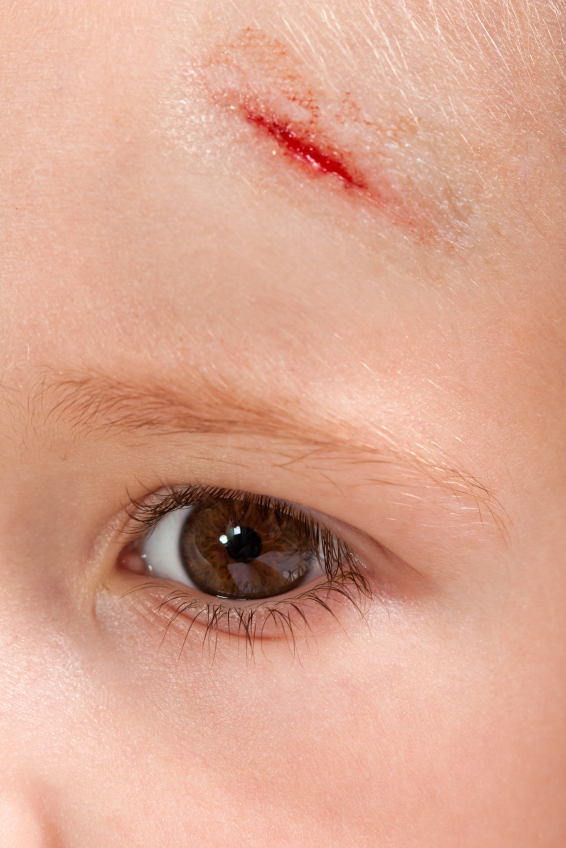Cuts and scrapes
No childhood is complete without a few cuts and scrapes. Some are serious and need immediate medical attention, others can be simply cleaned and monitored at home. The management depends on whether the injury is minor/superficial or major/deep:
Minor abrasions/scrapes/cuts
These are superficial injuries to the surface that don't go through the full thickness of skin. Sometimes they are thin like a paper cut, other times they are wide like a scraped knee. These can all be safely managed at home, and monitored for signs of infection.
Management
- Rinse the wound with body-temp clean water (feels neither hot nor cold) to remove dirt and debris.
- Wash with a gentle soap/cleanser and water to remove bacteria.
- Do not use an antiseptic like hydrogen peroxide, which can damage the sensitive tissue or cause reactions.
- Cover the wound with non-stick gauze or a self-adhesive bandage to prevent debris from entering wound.
- Antibiotic ointment is typically not necessary, just keep the wound clean. If you do choose to apply an antibiotic ointment, do not use anything with neomycin, which frequently causes allergic reactions in children.
- Change the bandage daily, as well as any time it gets wet or dirty.
- Once a scab has formed, bandage is no longer needed.
Signs to watch for
Come in for an appointment if:
- spreading redness from wound
- pus/discharge
- swollen and tender
- hot to touch
Deeper cuts/lacerations
These are cuts that go through the full thickness of the skin layer, and generally require medical attention.
Initial management
- Rinse the wound with body-temp clean water (feels neither hot nor cold) to remove dirt and debris.
- Examine the wound to see how deep and how wide it is.
- If bleeding:
- Elevate that part of the child's body above their heart.
- Place sterile gauze over wound
- Apply mild to moderate steady pressure to gauze for 5 minutes.
- Do NOT lift gauze to check during this time
Laceration needs same-day assessment/repair if:
- Gaping (edges of wound are separated from each other)
- More than half an inch long
- Deep puncture or animal bite
- Bleeding doesn't stop
- Injury to vital structures (eye, lips, tendon, blood vessels, etc.)
- Tetanus immunization not up to date
- Child has other concerning symptoms (head injury, loss of consciousness, altered mental status, abnormal breathing, etc).
If none of the above criteria are met for assessment, such as a smaller laceration not involving vital structures that has closed spontaneously (edges are touching), stopped bleeding, tetanus up to date, and wasn't a dirty wound, puncture wound or animal bite, it can be safe to monitor at home for signs of infection (see minor cuts/scrapes section above). Otherwise:
Where to go
My office (or urgent care if after hours) is appropriate if wound is:
- relatively minor
- not majorly gaping or under tension
- less than about 1 inch
- not immediately adjacent to eye
- not under tension
- child is not in distress, is alert and responsive
Emergency Room is best if:
- wound larger than 1 inch
- wound widely gaping
- bleeding does not stop with 5 minutes of pressure
- wound close to vital structure like the eye
- involves injury to vital structures (eye, lips, tendon, blood vessels, etc.)
- child is in distress or has other concerning symptoms.
Same-day appointments
For urgent needs, same-day appointments are available Monday through Friday. Please call as early in the day as possible, the more notice we have the easier it is to fit everyone in.
Need help outside of office hours?
Firstly, if your child has an emergency, please call 911 or go directly to the ER - they will contact us if needed once your child has been evaluated.
Urgent Care centers can also be helpful when something needs to be seen outside of office hours but it's not an emergency.
For our list of preferred Urgent Cares and ERs, see our resources page.
And if you have something that might need urgent attention but you're not sure/don't know what to do, we can help:






